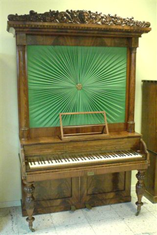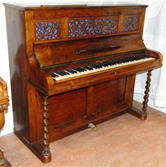Hammer instruments have hammers or mallets that strike the strings, one for each key. They are available in many variant forms with horizontal strings such as grand pianos and tables or upright strings such as grand pianos and cabinet pianos. The mechanics are adapted to whether the strings lie or stand.
The grand piano is normally wing-shaped and comes in different sizes. A variant is the “banana piano” which has a straight resonance pitch and therefore an external shape that swings off to the left, bent like a banana.




The square piano or table piano is usually rectangular (table-shaped from the German Tafel = table) but is also available with flared sides and is then called rubenesque (table piano). We usually call early squares without iron reinforcements hammer claviers. In these cases we write “taffel/hkl”(taffel hammerklavier) in the lists. The so-called The Ecke-piano is this category despite a table with a special construction, which was made in the 1930s in relatively few copies (about 40 pieces).




The upright piano (pianino) has existed in many varieties from very tall to small, low ones. Since the height of the body basically corresponds to the length of the strings plus the headstock, we indicate the height of the instrument without lid and wheels to indicate the model of the pianos we have.




